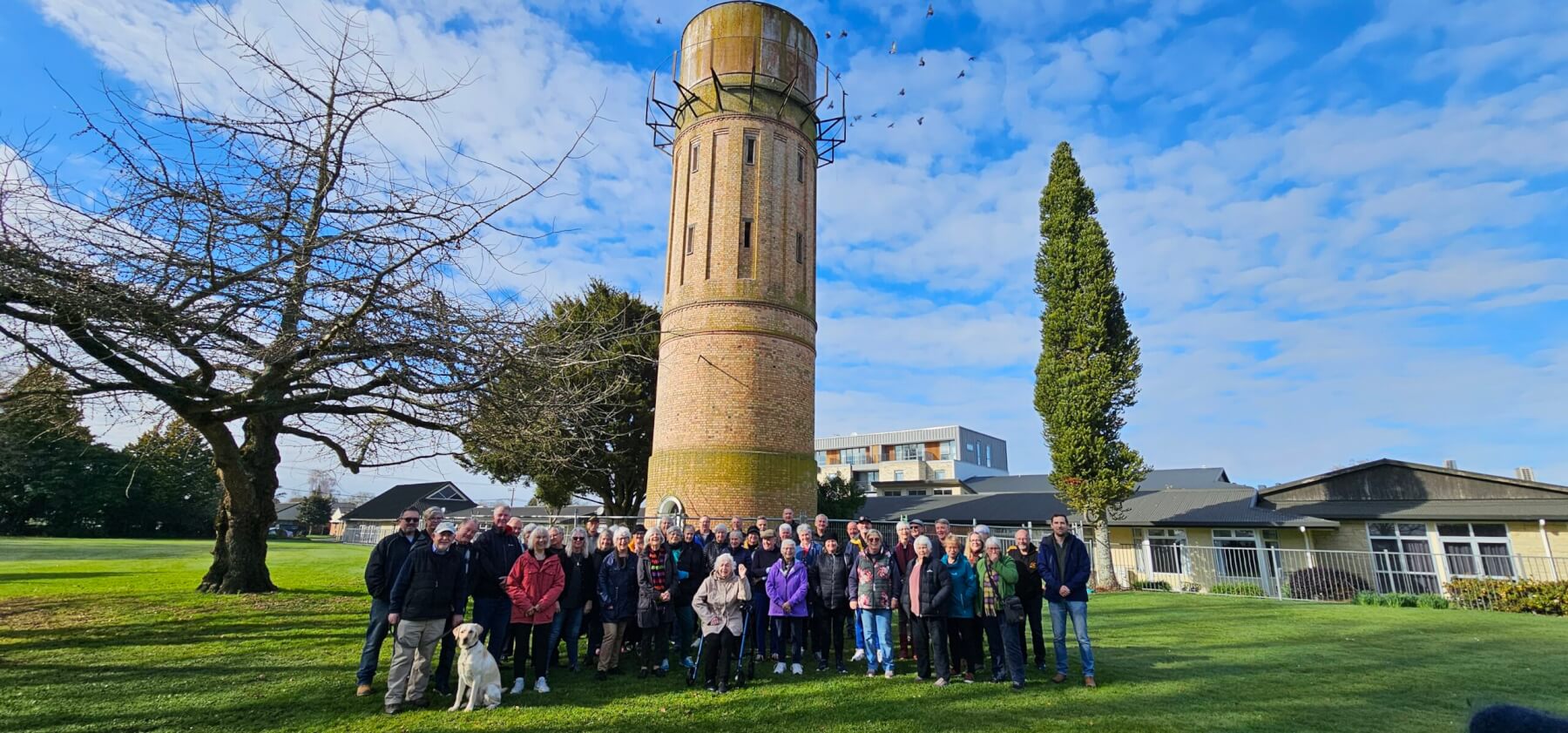
Save the Water Tower members
Battle lines have been drawn in Cambridge – one to see an under-threat water tower remain, the other to hear its 143-year-old church bells ringing again. Mary Anne Gill reports on Protecting their history.
A new Save the Cambridge Water Tower group signed up 50 members on Sunday and vows to have “meaningful” not “combative” conversations with Waipā District Council about the tower’s future.

Chair Peter Fulton told members the 24 metre high tower – built in 1902 to provide water for the growing town in what was then a sheep paddock – is now at the centre of a buzzing area.
“Why knock it down?”
New national earthquake building standards – introduced after the Canterbury and Kaikōura earthquakes – forced councils like Waipā to assess its buildings.
The water tower failed the seismic test and estimates of more than $6 million to fix it prompted the council to poll the community through its enhanced annual plan process.

Members of the newly-formed Save the Cambridge Water Tower. Photo: Mary Anne Gill
But Fulton argued the council only put two options to the community – bowl the tower over for $800,000 and use the bricks to build a feature on the site or restore it. Little wonder 62 per cent voted for the lower cost, he said.
There was a third option – keep it and find some investors.
“This is a great story for the community quite apart from the fact we want to save that building.
“We want to work with council, we are not going to be combative. The mayor has left the door open, so we want to put forward some ideas to her and council about what they (heritage experts) call adaptive reuse.”
Tamahere resident John Waterhouse said he bought a unit in the neighbouring Resthaven Retirement Village – less than 20 metres from the tower – for his mother in 2018.
At the time of purchase he was told the water tower was coming down but was heartened to hear that because of its historic classification, it would remain. The circular structure has been listed in the Waipā District Plan since 2010 as a Category A historic building.

The opening of Cambridge Resthaven. Photo: Cambridge Museum.

Resthaven’s opening on November 25, 1972, directed by then Minister of Health and Social Welfare, Lance Adams-Schneider. With him are Jack and June Shannon, Mrs Adams-Schneider, David and Barbara Jecks, and Mr and Mrs Ted Wright. Photo: Cambridge Museum
Resthaven opened in 1972 with retirement cottages. A geriatric hospital and an intermediate care wing opened in 1974, 1979 and 1985, encroaching ever closer to the water tower.

Fencing around the Cambridge Water Tower went up in 2000 and has cost $12,000. Photo: Mary Anne Gill.
Waterhouse argues Resthaven, a community-owned trust, is worried about the risks the tower presents for its residents – but it was council which allowed Resthaven to expand right up to the water tower.
“The structure is not about to fall over, despite no active maintenance over the tower’s lifetime, Cambridge is not a ‘known active fault area’,” Waterhouse has told Heritage New Zealand who he has enlisted to help save the tower.
“The limit of the council maintenance has been to put rented wire fence units around the tower, creating an eyesore, to mitigate the risk of falling ironwork from the external viewing platform which has rusted and is falling off the building.
“The cost to remove the walkway steelwork from the building would be small, but this has not been done, even though it was a small cost and an easy and obvious step.”
Council Property Services manager David Varcoe said the tower was first fenced off in January 2020. To date the fencing has cost $12,000.
“The grass behind the fence has not been mowed as it has been identified as a health and safety risk due to falling debris.

David Varcoe
“Under legislation, we are required to take practicable steps to ensure the safety of our staff when hazards are identified.”
Removal of the walkway steelwork is a simple, fast, low-cost task and could see the eyesore issues removed, said Waterhouse.
“The tower is capable of standing for at least another 10 years, whilst a more considered, less commercially coloured view of its future could be considered,” said Waterhouse.

Cambridge Water Tower during construction. Photo: Cambridge Museum Collection.
The tower was built with bricks laid in the English bond pattern – renowned for its strength – with decorative features that included a regular pattern of bluestone topped ventilation windows and several horizontal rows of brick dentil pattern.
It is topped by a brick-lined metal tank and lead roof that held 90,922 litres (20,000 gallons) with a viewing platform around the top perimeter.
It was decommissioned in 1926 when the Moon’s Spring, from which the tower drew its water supply, was found to be polluted.

Save the Cambridge Water Tower group founders, from left, Dave Linthwaite, Elizabeth Harvey, Peter Fulton, David Griffin, James Casey, Mike Kilgour. Photo: Mary Anne Gill.

The water tower in the background of this photo taken in January 1972 during the construction of the Resthaven main block. Photo: Cambridge Museum Collection.

The water tower in the background of this photo taken in January 1972 during the construction of the Resthaven main block. Photo: Cambridge Museum Collection.

The water tower in the background of this photo taken in January 1972 during the construction of the Resthaven main block. Photo: Cambridge Museum Collection.

The water tower in the background of this photo taken in January 1972 during the construction of the Resthaven main block. Photo: Cambridge Museum Collection.

An aerial view of the water tower and Resthaven taken in 1999. Photo: Cambridge Museum Collection.

A drone shot taken in July 2024. Photo: Brian Holden.








